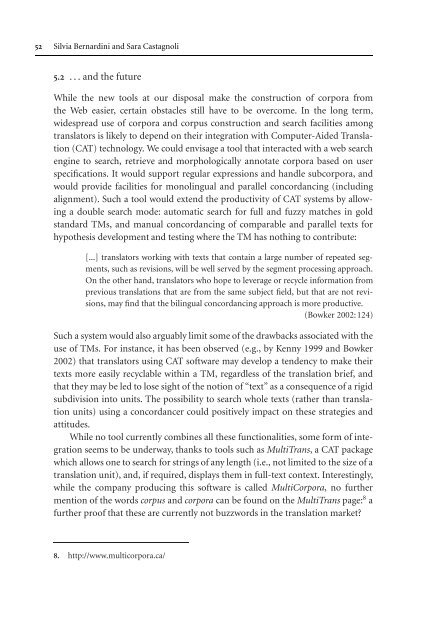Topics in Language Resources for Translation ... - ymerleksi - home
Topics in Language Resources for Translation ... - ymerleksi - home
Topics in Language Resources for Translation ... - ymerleksi - home
- No tags were found...
You also want an ePaper? Increase the reach of your titles
YUMPU automatically turns print PDFs into web optimized ePapers that Google loves.
52 Silvia Bernard<strong>in</strong>i and Sara Castagnoli5.2 ...andthefutureWhile the new tools at our disposal make the construction of corpora fromthe Web easier, certa<strong>in</strong> obstacles still have to be overcome. In the long term,widespread use of corpora and corpus construction and search facilities amongtranslators is likely to depend on their <strong>in</strong>tegration with Computer-Aided <strong>Translation</strong>(CAT) technology. We could envisage a tool that <strong>in</strong>teracted with a web searcheng<strong>in</strong>e to search, retrieve and morphologically annotate corpora based on userspecifications. It would support regular expressions and handle subcorpora, andwould provide facilities <strong>for</strong> monol<strong>in</strong>gual and parallel concordanc<strong>in</strong>g (<strong>in</strong>clud<strong>in</strong>galignment). Such a tool would extend the productivity of CAT systems by allow<strong>in</strong>ga double search mode: automatic search <strong>for</strong> full and fuzzy matches <strong>in</strong> goldstandard TMs, and manual concordanc<strong>in</strong>g of comparable and parallel texts <strong>for</strong>hypothesis development and test<strong>in</strong>g where the TM has noth<strong>in</strong>g to contribute:[...] translators work<strong>in</strong>g with texts that conta<strong>in</strong> a large number of repeated segments,such as revisions, will be well served by the segment process<strong>in</strong>g approach.On the other hand, translators who hope to leverage or recycle <strong>in</strong><strong>for</strong>mation fromprevious translations that are from the same subject field, but that are not revisions,may f<strong>in</strong>d that the bil<strong>in</strong>gual concordanc<strong>in</strong>g approach is more productive.(Bowker 2002:124)Such a system would also arguably limit some of the drawbacks associated with theuse of TMs. For <strong>in</strong>stance, it has been observed (e.g., by Kenny 1999 and Bowker2002) that translators us<strong>in</strong>g CAT software may develop a tendency to make theirtexts more easily recyclable with<strong>in</strong> a TM, regardless of the translation brief, andthat they may be led to lose sight of the notion of “text” as a consequence of a rigidsubdivision <strong>in</strong>to units. The possibility to search whole texts (rather than translationunits) us<strong>in</strong>g a concordancer could positively impact on these strategies andattitudes.While no tool currently comb<strong>in</strong>es all these functionalities, some <strong>for</strong>m of <strong>in</strong>tegrationseems to be underway, thanks to tools such as MultiTrans,aCATpackagewhich allows one to search <strong>for</strong> str<strong>in</strong>gs of any length (i.e., not limited to the size of atranslation unit), and, if required, displays them <strong>in</strong> full-text context. Interest<strong>in</strong>gly,while the company produc<strong>in</strong>g this software is called MultiCorpora, nofurthermention of the words corpus and corpora can be found on the MultiTrans page: 8 afurther proof that these are currently not buzzwords <strong>in</strong> the translation market?8. http://www.multicorpora.ca/
















